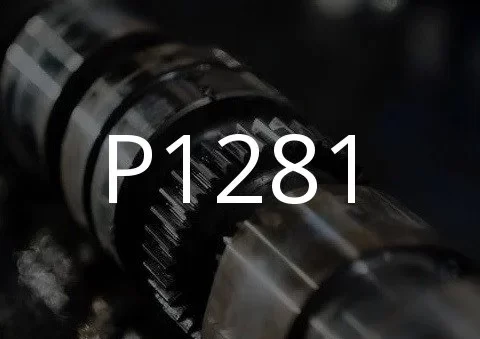
P1281 (Volkswagen, Audi, Skoda, Seat) Fuel quantity control solenoid valve - short circuit to ground
Content
P1281 – OBD-II Trouble Code Technical Description
Trouble code P1281 indicates a short to ground in the fuel quantity control solenoid valve circuit in Volkswagen, Audi, Skoda, and Seat vehicles.
What does the fault code mean P1281?
Trouble code P1281 is a diagnostic trouble code that indicates a problem with the vehicle's fuel quantity control solenoid valve. This valve is responsible for regulating the amount of fuel entering the engine, which affects its performance and efficiency. When the system detects a short to ground in this valve's circuit, it indicates a possible problem with the electrical connection or the valve itself. Problems such as these can result in improper fuel delivery to the engine, which can cause rough running, loss of power, poor fuel economy, and other vehicle performance problems.

Possible reasons
Trouble code P1281 can be caused by various reasons:
- Solenoid valve failure: The valve itself or its control circuitry may be damaged or faulty. This may occur due to wear, corrosion, broken wiring, or other mechanical damage.
- Short circuit to ground in the solenoid valve circuit: The wiring connected to the solenoid valve may have a short to ground, causing P1281.
- Problems with electrical connections: Poor contact quality, oxidation, or open electrical connections in the engine management system can cause P1281.
- Problems with sensors or fuel consumption sensors: Sensors responsible for measuring fuel consumption or other engine parameters may be faulty or produce inaccurate data, which may cause the solenoid valve to not operate properly.
- Problems with the fuel injection system: Incorrect fuel pressure, clogged fuel filters, or other problems with the fuel injection system can also cause P1281.
- Problems with the ECU (electronic control unit): Faults or errors in the ECU software can cause the solenoid valve to not operate properly and therefore cause P1281.
A thorough diagnosis of all of these components and systems will help you pinpoint the cause of P1281 and resolve it.
What are the symptoms of a fault code? P1281?
The following symptoms may occur with a P1281 code:
- Unstable engine performance: The fuel quantity control solenoid valve is responsible for regulating the fuel supply to the engine. If it is malfunctioning or not operating properly, the engine may run erratically, including shaking, shaking, or rough idling.
- Loss of power: Improper fuel delivery to the engine may result in loss of power when accelerating or driving at high speeds.
- Deterioration in fuel economy: Improper operation of the solenoid valve can result in under- or over-fueling, which in turn can affect fuel consumption, making it less efficient.
- Other error codes appear: In some cases, the P1281 code may be accompanied by other error codes related to the operation of the fuel injection system or engine management.
- Loss of idle stability: Incorrect operation of the fuel quantity control valve can lead to loss of idle stability, which manifests itself in sudden fluctuations in engine speed or its incorrect operation when stopping at a traffic light or in a traffic jam.
- Increased emissions of harmful substances: Insufficient fuel supply or improper mixing with air can lead to increased emissions of harmful substances such as nitrogen oxides or hydrocarbons.
These symptoms can occur in varying degrees and may be associated not only with the P1281 code, but also with other problems in the fuel injection or engine management system.
How to diagnose a fault code P1281?
To diagnose DTC P1281, follow these steps:
- Checking the error code: You must first use a diagnostic scanner or trouble code reader to confirm the presence of P1281. This will help confirm that there is indeed a problem and begin to find the cause.
- Visual inspection of the solenoid valve: Check the condition and integrity of the solenoid valve. Make sure that the wires connected to the valve are not damaged and that the connections are not oxidized.
- Checking electrical connections: Inspect the electrical connections in the solenoid valve circuit for damage, corrosion, or breaks. Pay special attention to the contacts and connectors.
- Solenoid Valve Testing: Use a multimeter to check the resistance of the solenoid valve. The resistance should be within normal limits according to the manufacturer's specifications.
- Checking sensors and fuel consumption sensors: Check the fuel flow sensors and other sensors associated with the fuel delivery system to ensure they are operating correctly.
- ECU diagnostics: If all other components appear to be OK, the Electronic Control Unit (ECU) should be diagnosed to ensure there are no software errors and that the ECU is controlling the solenoid valve correctly.
- Checking other fuel supply systems: Check the fuel injection system for problems such as low fuel pressure or clogged fuel filters, which can also cause P1281.
After thoroughly diagnosing all possible causes of error P1281, you can begin to resolve the detected problems. If you cannot diagnose it yourself, it is recommended that you contact a professional automotive technician or service center.
Diagnostic errors
When diagnosing DTC P1281, the following errors may occur:
- Insufficient diagnosis: Sometimes mechanics may immediately assume that the problem is solely with the solenoid valve, without conducting a full diagnosis of the entire fuel system. This may cause you to miss other potential causes, such as electrical problems, damaged wiring, or problems with sensors.
- Replacing a part without analyzing the cause: Sometimes mechanics may jump straight into replacing the solenoid valve without conducting a detailed analysis of the cause of the error. As a result, this may cause the problem to persist if the root cause is not addressed.
- Incorrect interpretation of code: Diagnostic codes can be quite general, and some mechanics may misinterpret the P1281 code as an electrical problem when the cause may be related to other aspects of the fuel system.
- Ignoring related problems: Sometimes the problem causing the P1281 code can be related to other related problems, such as problems with the fuel pump or fuel pressure. Ignoring these issues may result in the root cause of the error remaining unresolved.
To successfully diagnose a P1281 code, it is important to perform a comprehensive inspection of the fuel system, including electrical components, wiring, sensors, and solenoid valve to accurately identify and correct the cause of the code.
How serious is the fault code? P1281?
Trouble code P1281 is serious because it indicates a problem with the fuel quantity control solenoid valve in the vehicle's system. Despite the fact that in some cases the car may continue to operate, neglecting this error can lead to a number of negative consequences:
- Loss of power and efficiency: Improper fuel delivery can cause loss of engine power and poor fuel economy, which will reduce vehicle performance and increase fuel consumption.
- Increased emissions of harmful substances: Improper operation of the fuel injection system can lead to increased emissions of harmful substances, which can negatively affect the vehicle's environmental friendliness and its compliance with emission standards.
- Damage to other components: If the solenoid valve problem is not corrected in a timely manner, it may cause damage to other fuel or engine management components, which may increase the cost of repairs.
- Potential road hazards: Incorrect engine operation due to P1281 can reduce vehicle controllability and increase the risk of an accident or emergency situation on the road.
So, while some drivers may try to ignore this error, it is recommended to immediately contact a qualified automotive technician to diagnose and fix the problem to prevent possible serious consequences.
What repair will help eliminate the code? P1281?
Troubleshooting P1281 may include several possible repairs depending on the source of the problem:
- Solenoid valve replacement or repair: If the fuel quantity control solenoid valve is truly faulty, it may need to be replaced or repaired. This may include removing and replacing the valve and checking electrical connections.
- Repairing a short circuit to ground: If the problem is a short to ground in the solenoid valve circuit, the short circuit must be located and repaired. This may require repairing damaged wiring or replacing components.
- Checking and cleaning electrical connections: Poor contacts or oxidation of electrical connections may be the cause of the P1281 code. In this case, cleaning or replacing the connections may help resolve the problem.
- Diagnostics and repair of other system components: If the problem is not directly related to the solenoid valve, additional diagnostic and repair measures may be required. For example, repairing sensors, diagnosing the fuel injection system or replacing fuel consumption sensors.
- Reprogramming or replacing the ECU: In rare cases, the problem may be due to software errors or a malfunction in the ECU itself. In this case, reprogramming or replacement of the engine control unit may be necessary.
After completing the repair, it is recommended that you test and clear the P1281 error code using a diagnostic scan tool to ensure that the problem has been successfully resolved. If the cause of the error has not been completely resolved, additional diagnostics and repairs may be required.

